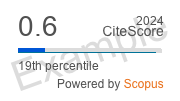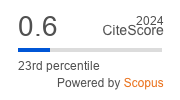Concept of automatic development of polymer heart valve prosthesis
https://doi.org/10.29001/2073-8552-2025-40-3-225-234
Abstract
Aim: To validate an automated design algorithm for the leaflet apparatus of a polymeric heart valve prosthesis, focusing on achieving high hydrodynamic performance through design, prototyping, and in vitro testing.
Material and Methods. The study employs a proprietary automated design algorithm based on computational modeling and numerical analysis of the hydrodynamic characteristics of heart valve prosthesis leaflets in computational modeling. The algorithm generated a large number of geometrical variants (over 16,000), which were subsequently evaluated for their functionality, including the effective orifice area, coaptation area, and stress distribution within the leaflet material. Based on the design algorithm's output, the optimal leaflet geometry was selected and prototyped using casting techniques to produce three samples. These prototypes were evaluated in vitro under simulated physiological flow conditions using a hydrodynamic testing system.
Results. The geometries produced by the design algorithm exhibited a wide range of quantitative metrics for the targets: the mean effective orifice area was 38.85% (minimum 7.54%; maximum 85.78%); the coaptation area was 1.08% (0–1.88%); and the maximum stress was 0.47 MPa (0.25–1.43 MPa). The optimal leaflet geometry selected for prototyping demonstrated an effective orifice area of 85.75%, a coaptation area of 0.45%, and a maximum stress of 1.023 MPa. Prototyping and subsequent in vitro testing confirmed the high functional performance of the developed sample, although significant deviations in quantitative indicators from the results of numerical modeling were observed due to the specifics of prototyping. These discrepancies indicate the need for further refinement of the algorithm and improvements in the prototyping methodology.
Conclusion. The study confirms the effectiveness of the proposed automated algorithm for the development and optimization of polymeric heart valve prostheses. The primary advantage of this methodology lies in its ability to rapidly generate and evaluate a large number of geometrical variants, thereby enhancing the accuracy and functionality of the final product. The results demonstrate the significant potential of automated design in biomedical engineering and pave the way for the development of more advanced medical devices. Future efforts should focus on improving the accuracy of numerical models and prototyping techniques to ensure even higher quality and durability of polymeric heart valve prostheses.
Keywords
About the Authors
K. Yu. KlyshnikovRussian Federation
Kirill Yu. Klyshnikov - Cand. Sci. (Med.), Senior Research Scientist, Laboratory of New Biomaterials, Department of Experimental Medicine, NII KPSSZ.
6, Barbarash Boulevard, Kemerovo, 650002
P. S. Onishchenko
Russian Federation
Pavel S. Onishchenko - Junior Research Scientist, Laboratory of New Biomaterials, Department of Experimental Medicine, NII KPSSZ.
6, Barbarash Boulevard, Kemerovo, 650002
T. V. Glushkova
Russian Federation
Tatyana V. Glushkova - Cand. Sci. (Biol.), Senior Research Scientist, Laboratory of New Biomaterials, Department of Experimental Medicine, NII KPSSZ.
6, Barbarash Boulevard, Kemerovo, 650002
A. E. Kostyunin
Russian Federation
Alexander E. Kostyunin - Cand. Sci. (Biol.), Senior Research Scientist, Laboratory of New Biomaterials, Department of Experimental Medicine, NII KPSSZ.
6, Barbarash Boulevard, Kemerovo, 650002
T. N. Akentyeva
Russian Federation
Tatyana N. Akentуeva - Junior Research Scientist, Laboratory of New Biomaterials, Department of Experimental Medicine, NII KPSSZ.
6, Barbarash Boulevard, Kemerovo, 650002
N. N. Borisova
Russian Federation
Natalia N. Borisova - Junior Research Scientist, Laboratory of New Biomaterials, Department of Experimental Medicine, NII KPSSZ.
6, Barbarash Boulevard, Kemerovo, 650002
E. A. Ovcharenko
Russian Federation
Evgeny A. Ovcharenko - Cand. Sci. (Tech.), Head of the Laboratory of New Biomaterials, Department of Experimental Medicine, NII KPSSZ.
6, Barbarash Boulevard, Kemerovo, 650002
References
1. Bokeria L.A., Milievskaya E.B., Pryanishnikov V.V., Yurlov I.A. Cardiovascular surgery – 2023. Diseases and congenital abnormalities of the circulatory system. Moscow: A.N. Bakulev National medical research center for cardiovascular surgery of the Russian Ministry of Health; 2024:368. (In Russ.)
2. Barbarash L.S., Rogulina N.V., Rutkovskaya N.V., Ovcharenko E.A. Mechanisms underlying bioprosthetic heart valve dysfunctions. Complex Issues of Cardiovascular Diseases. 2018;7(2):10–24. (In Russ.). https://doi.org/10.17802/2306-1278-2018-7-2-10-24.
3. Li K. Sun W. Simulated transcatheter aortic valve deformation: A parametric study on the impact of leaflet geometry on valve peak stress. Int. J. Numer. Method. Biomed. Eng. 2017;33(3):e02814. https://doi.org/10.1002/cnm.2814.
4. Li K., Sun W. Simulated thin pericardial bioprosthetic valve leaflet deformation under static pressure-only loading conditions: Implications for percutaneous valves. Ann Biomed Eng. 2010;38(8):2690–2701. https://doi.org/10.1007/s10439-010-0009-3.
5. Travaglino S., Murdock K., Tran A., Martin C., Liang L., Wang Y. et al. Computational Optimization Study of Transcatheter Aortic Valve Leaflet Design Using Porcine and Bovine Leaflets. J. Biomech. Eng. 2020;142(1):011007. https://doi.org/10.1115/1.4044244.
6. Sellers S.L., Blanke P., Leipsic J.A. Bioprosthetic heart valve degeneration and dysfunction: Focus on mechanisms and multidisciplinary imaging considerations. Radiol. Cardiothorac. Imaging. 2019;1(3):e190004. https://doi.org/10.1148/ryct.2019190004.
7. Pankratova O.A., Shumovets V.V., Pankratov A.V., Tikhonovets V.V., Kurlovich I.V. Mechanical heart valves and pregnancy. Meditsinskie novosti. 2018;284(5):15–17. (In Russ.). URL: https://www.mednovosti.by/Journal.aspx?id=384 (11.09.2025).
8. Burriesci G., Marincola F.C., Zervides C. Design of a novel polymeric heart valve. J. Med. Eng. Technol. 2010;34(1):7–22. https://doi.org/10.3109/03091900903261241
9. Stasiak J.R., Serrani M., Biral E., Taylor J.V., Zaman A.G., Jones S. et al. Design, development, testing at ISO standards and: In vivo feasibility study of a novel polymeric heart valve prosthesis. Biomater. Sci. 2020;8(16):4467–4480. https://doi.org/10.1039/d0bm00412j.
10. Claiborne T.E., Sheriff J., Kuetting M., Steinseifer U., Slepian M.J., Bluestein D. In vitro evaluation of a novel hemodynamically optimized trileaflet polymeric prosthetic heart valve. J. Biomech. Eng. 2013;135(2):021021. https://doi.org/10.1115/1.4023235.
11. Singh S.K., Kachel M., Castillero E., Xue Y., Kalfa D., Ferrari G. et al. Polymeric prosthetic heart valves: A review of current technologies and future directions. Front. Cardiovasc. Med. 2023;10:1137827. https://doi.org/10.3389/fcvm.2023.1137827.
12. Yakubov S. Foldax Tria: First-in-Human Implant of a Totally Synthetic Polymeric Aortic Valve. (2019). https://cdn.prod.website-files.com/651b18f962cb88823decb389/651b623b8fddb7b0012d65c9_CRT-2020-DrYakubov-PPT-FINAL.pdf (11.09.2025).
13. Onishchenko P.S., Klyshnikov, K.Yu. Ovcharenko E.A. Optimization of the biological heart valve prosthesis “UniLine”: new tools for improving function. Russian journal of biomechanics. 2024;28(1):10–22. https://doi.org/10.15593/RZhBiomeh/2024.1.01.
14. Maiorov A.P., Tarasov V.M., Goncharenko A.M., Glushkova T.V., Burago A.Yu. Laser cutting of cardiovascular prosthesis elements. Al'manakh klinicheskoi meditsiny. 2008;17(2):115. EDN: ITVYRZ
15. Wu C., Saikrishnan N., Chalekian A.J., Fraser R., Ieropoli O., Retta S.M. et al. In-vitro pulsatile flow testing of prosthetic heart valves: A roundrobin study by the ISO cardiac valves working group. Cardiovasc. Eng. Technol. 2019;10(3):397–422. https://doi.org/10.1007/s13239-019-00422-5.
Review
For citations:
Klyshnikov K.Yu., Onishchenko P.S., Glushkova T.V., Kostyunin A.E., Akentyeva T.N., Borisova N.N., Ovcharenko E.A. Concept of automatic development of polymer heart valve prosthesis. Siberian Journal of Clinical and Experimental Medicine. 2025;40(3):225-234. (In Russ.) https://doi.org/10.29001/2073-8552-2025-40-3-225-234





.png)





























